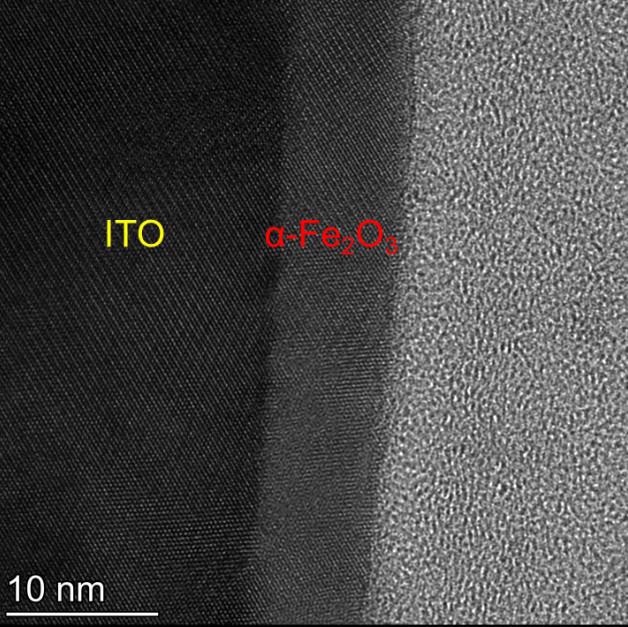Apr 20 2021
Metal oxides, including rust, are fascinating photoelectrode materials that are used for producing green hydrogen with solar light.
 Rust would be an extremely cheap and stable photoelectrode material to produce green hydrogen with light. But the efficiency is limited. The TEM image shows a photoanode containing a thin photoactive layer of rust. Image Credit: © Technion.
Rust would be an extremely cheap and stable photoelectrode material to produce green hydrogen with light. But the efficiency is limited. The TEM image shows a photoanode containing a thin photoactive layer of rust. Image Credit: © Technion.
Metal oxides are also economical and abundantly available but despite years of studies, not much progress has been made.
Now, a team of researchers from Helmholtz-Zentrum Berlin (HZB), along with associates from Ben Gurion University and the Technion in Israel, has examined the optoelectronic characteristics of hematite (rust) and other similar metal oxides in unparalleled detail.
The team’s results demonstrate that the highest possible efficiency of hematite electrodes is considerably lower than assumed before. The new study reveals ways to evaluate novel photoelectrode materials in a more realistic manner.
Large quantities of hydrogen will be required to use it as a raw material or energy carrier in the upcoming energy system. But to achieve this, hydrogen should be generated in a climate-neutral manner, for instance, through the supposed photoelectrolysis process by using solar light to break down water into oxygen and hydrogen.
Semiconducting materials are photoelectrodes that are required to transform solar light into electricity and these materials remain stable in water. Among the ideal candidates for low-cost and stable photoelectrodes are metal oxides. Besides this, a few of these metal oxides have catalytically active surfaces that speed up the formation of oxygen at the anode or hydrogen at the cathode.
Why is Rust Not Much Better?
Studies have traditionally targeted hematite (α-Fe2O3), which is extensively known as rust. Hematite is extremely cost-effective, remains stable in water, and is suitable as a photoanode with a proven catalytic activity for the evolution of oxygen.
While studies on hematite photoanodes have been ongoing for around five decades, the photocurrent conversion efficiency is below 50% of the theoretical maximum value. On the other hand, the photocurrent efficiency of silicon—a semiconductor material silicon that currently dominates virtually 90% of the photovoltaic market—is around 90% of the theoretical maximum value.
This has intrigued scientists for a long time. So, what precisely was ignored? What is the reason for achieving just modest increases in efficiency?
Israeli-German Team Solves the Puzzle
In a new study published in the Nature Materials journal, a research team headed by Dr Daniel Grave from Ben Gurion University, Dr Dennis Friedrich from HZB, and Professor Dr Avner Rothschild from Technion has explained why hematite falls below the estimated maximum value.
The Technion team studied how the wavelength of absorbed light in thin films of hematite has an impact on the photoelectrochemical characteristics, whereas the HZB group used time-resolved microwave measurements to establish the wavelength-dependent charge carrier characteristics in thin films of rust.
Fundamental Physical Property Extracted
By integrating their results, the investigators effectively extracted the photogeneration yield spectrum—an underlying physical characteristic of the material that was typically overlooked when considering inorganic solar absorbers.
Roughly speaking, this means that only part of the energy of the light absorbed by haematite generates mobile charge carriers, the rest generates rather localised excited states and is thus lost.
Dr Daniel Grave, Ben Gurion University
Rust Will Not Get Much Better
“This new approach provides experimental insight into light-matter interaction in haematite and allows distinguishing its optical absorption spectrum into productive absorption and non-productive absorption,” stated Rothschild.
We could show that the effective upper limit for the conversion efficiency of haematite photoanodes is significantly lower than that expected based on above band-gap absorption.
Dr Daniel Grave, Ben Gurion University
As per the new estimation, present-day “champion” hematite photoanodes have already reached rather close to the theoretical maximum value, so it does not get much better than this.
Assessing New Photoelectrode Materials
The new method has also been successfully used on a model material TiO2 and the present best-performing metal oxide photoanode material BiVO4.
With this new approach, we have added a powerful tool to our arsenal that enables us to identify the realizable potential of photoelectrode materials. Implementing this to novel materials will hopefully expedite the discovery and development of the ideal photoelectrode for solar water splitting. It would also allow us to ‘fail quickly’, which is arguably just as important when developing new absorber materials.
Dr Dennis Friedrich, Helmholtz-Zentrum Berlin
Journal Reference:
Grave, D. A., et al. (2021) Extraction of mobile charge carrier photogeneration yield spectrum of ultrathin-film metal oxide photoanodes for solar water splitting. Nature Materials. doi.org/10.1038/s41563-021-00955-y.